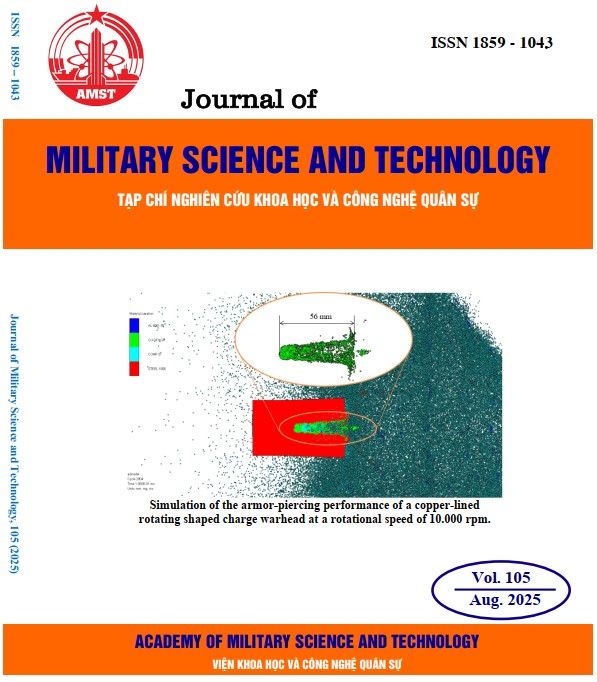Evaluation of nitrate removal efficiency from aqueous solutions using modified biochar derived from coffee husk
302 viewsDOI:
https://doi.org/10.54939/1859-1043.j.mst.105.2025.75-82Keywords:
Adsorption; Biochar; Coffee husk; Nitrate (NO₃⁻)-Abstract
This study presents the fabrication and evaluation of the nitrate adsorption capacity of modified biochar derived from coffee husk. The coffee husks were initially pyrolyzed at 350 °C for 1 hour, then soaked in 1 M KOH solution for 24 hours, followed by a second pyrolysis step at 700 °C for 2 hours. The resulting biochar was characterized using FT-IR, BET, and SEM techniques, and its nitrate removal efficiency from aqueous solutions was investigated. The highest nitrate removal efficiency (82.38%) was achieved under the following conditions: pH 3, biochar dosage of 1,5 g/100 mL, nitrate concentration of 50 mg/L, and reaction time of 210 minutes. The pseudo-first-order kinetic model and the Langmuir isotherm model were applied to describe the adsorption behavior, showing good agreement with the experimental data.
References
[1]. Case studies in enviromental medicine-nitrate/nitrite toxicity, ATSDR, (2013).
[2]. R. Picetti et al., “Nitrate and nitrite contamination in drinking water and cancer risk: A systematic review with meta-analysis”, Environ. Res., 210, 112988, (2022). DOI: https://doi.org/10.1016/j.envres.2022.112988
[3]. A. Kapoor, T. Viraraghavan, “Nitrate removal from drinking water-review”, J Environ. Eng., 123, pp. 371-380, (1997). DOI: https://doi.org/10.1061/(ASCE)0733-9372(1997)123:4(371)
[4]. J. Younker , L. Zamlynny, C. Spearns, J. Rand, “Nitrate management in a rural drinking water supply”, J Water Process Eng., 43, 102301, (2021). DOI: https://doi.org/10.1016/j.jwpe.2021.102301
[5]. H.H. Kinfu et al., “Metal-phenolic network-based NF membranes for nitrate removal and the utilization of DSPM-DE model”, Chemical Engineering Journal. 162841 (2025). DOI: https://doi.org/10.1016/j.cej.2025.162841
[6]. J. Li, J. Li, H. Mu, H. Xie, W. Zhao, “Immobilization Technology of Aerobic Denitrifying Bacteria and Its Enhanced Biological Denitrification: A Review of Recent Advances”, Water. 17, 1433, (2025). DOI: https://doi.org/10.3390/w17101433
[7]. Z. Zhang, Y. Zhang, and Y. Chen, “Recent advances in partial denitrification in biological nitrogen removal: From enrichment to application”, Bioresource Technology, 298, 122444, (2020). DOI: https://doi.org/10.1016/j.biortech.2019.122444
[8]. S. Muhammad et al., “Insights into agricultural-waste-based nano-activated carbon fabrication and modifications for wastewater treatment application”, Agriculture, 12, 1737, (2022). DOI: https://doi.org/10.3390/agriculture12101737
[9]. https://nongnghiepmoitruong.vn/gia-tri-cua-vo-ca-phe-d229843.html
[10]. Z. Heidarinejad et al., “Methods for preparation and activation of activated carbon: A review”, Environmental Chemistry Letters, 18, 393-415, (2020). DOI: https://doi.org/10.1007/s10311-019-00955-0
[11]. N.-T. Vu, and K.-U. Do, “Insights into adsorption of ammonium by biochar derived from low temperature pyrolysis of coffee husk”, Biomass Conversion Biorefinery, 13, 2193-2205, (2023). DOI: https://doi.org/10.1007/s13399-021-01337-9
[12]. Hafshejania et al., “Removal of Nitrate from Aqueous Solution by Modified Sugarcane Bagasse Biochar”, Ecological Engineering, 95, 101-11, (2016). DOI: https://doi.org/10.1016/j.ecoleng.2016.06.035
[13]. Viglašová et al., “Production, Characterization and Adsorption Studies of Bamboo-Based Biochar/Montmorillonite Composite for Nitrate Removal”, Waste Management, 79, 385-94, (2018). DOI: https://doi.org/10.1016/j.wasman.2018.08.005







